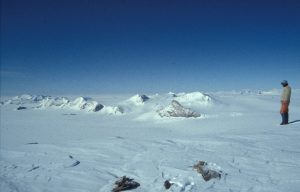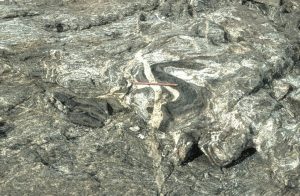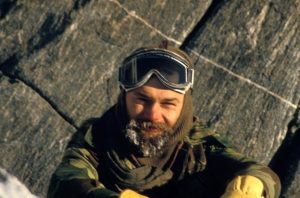Date/Time
Date(s) - 08/05/2024
7:30 pm - 9:00 pm
Categories No Categories
(venue opens at 6.30pm for socialising)
I had the great privilege of mapping the rocks and geology of the Sverdrupfjella mountain range in Queen Maud Land, Antarctica, the first geologist ever to do so. Over five summers, working as pairs (geologist and fieldy), we were airlifted by helicopter to the mountains where we camped for six to eight weeks, relying on our own transport by skidoo/sledge and a supply of dehydrated food.
The Antarctic mountains are perfect for geological mapping. Although outcrop is limited, the pristine, unweathered rocks along ridges and scarps provide terrific
3D exposure. This is especially valuable as the rocks studied are 1100 million years old high-grade metamorphosed sedimentary, volcanic and granitic rocks, in which recrystallization under stress has produced strongly schistose to gneissic foliations, and complex deformation by folding, refolding, shearing and faulting — very difficult to interpret.
Fortunately, remnants of metamorphic minerals survived in small pods and lenses of eclogite (a high-pressure metamorphic rock), and retained wonderfully preserved sets of mineral assemblages that indicate how these rocks were buried to depths of 30 to 40 km. This burial event can be dated at 580 to 550 million years ago. Furthermore, these mineral assemblages show evidence of reaction and transformation from these early high-pressure minerals to a secondary set of minerals indicative of re-equilibration at 15 to 20 km depth — this stage coincides with strong deformation of the rocks while they were exhumed. Detailed analysis of these minerals has provided a Pressure-Temperature-Time path that is typically observed in continental collision, with cool rocks buried at great depth, heated and melted, and later uplifted and deformed in the middle crust, before finally reaching the surface.
The age of the metamorphic events that the Sverdrupfjella rocks have endured matches with that of other mountain belts and provides particularly good evidence for the assembly of the East Gondwana supercontinent around 580 to 550 million years ago — and so, the amazing preservation of primary mineral assemblages in small boudins from Antarctica has contributed to understanding the collision of continents.


An Antarctic view and eclogite boudin in high-grade gneisses of the Sverdrupfjella, Antarctica. Photos courtesy Bruce Groenewald.

Bruce’s fascination with Antarctica led him to spend five freezing summers in Queen Maud Land while completing his PhD. After lecturing at the University of Natal, mostly in metamorphic petrology and crustal evolution, he moved to Windhoek and worked for the Geological Survey of Namibia for two years, mapping the Namaqua Orogenic Belt in the south of the country. In 1997, Bruce emigrated to Australia to join GSWA and lived in Kalgoorlie for more than eight years. His accomplishment there was digitising and assembling all 52 of the 1:100 000 scale maps of the Eastern Goldfields in the first three GIS databases published by GSWA, paving the way for the introduction of seamless State maps. Bruce returned to mineral exploration in 2008. After diverse projects involving exploration for copper, gold and lead-zinc in Australia and PNG, he contributed to proving large-scale deposits of bauxite in southwest Western Australia.
Bruce has maintained an interest in Earth science research, writing and co-authoring over 20 publications, mostly on Proterozoic geology and tectonics in Antarctica, as well as Archean geology and crustal history in South Africa and here in Western Australia.